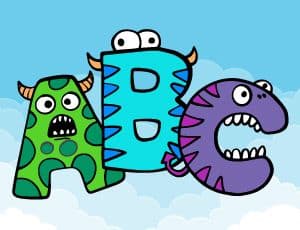Escola Games | Jogos Educativos
https://www.escolagames.com.br
Teacher's support sheet

Time to Paint Alphabet
How about learning the alphabet with monsters and colors? Play and have fun with this game! Choose a letter-monster and be creative: you can choose your style on the right side of the screen. Choose the color and hands-on!

Teacher's tips
Level of education: Elementary School
Age: 04 to 07 years old
Learning the alphabet is one of the first lessons for children when they start school. Learning letters is essential for complete and effective literacy. It is through the alphabet that children will learn to form their first words and develop their written communication. For this learning, there are tips on how to teach the letters to the little ones, among them the playful ways stand out. The use of music, games and paintings are one of the many ways to promote playful and effective learning. [FIM-DICA]
Learner outcomes
Identify, memorize and differentiate the letters of the alphabet;
Know the sequence of the alphabet;
Develop attention and concentration;
Develop motor coordination;
Develop creativity;
Understand the use of the alphabet in the construction of words;
Teachers' goals
Arouse in students an interest in learning arts;
Arouse in students an interest in learning Portuguese;
Enable the student to identify the alphabet as a stable set of symbols that graphically represents our speech;
Fix content worked in the classroom;
Offer a playful and pleasurable proposal that allows the student to associate letters with their spelling;
Offer the game as a didactic resource to fix the content worked in the classroom;
Expand students' knowledge;
Work with students on motor skills and artistic expression skills;
Suggestions of approaches for the teacher
(Suggestion 1) Make the letters of the Alphabet using EVA, then paste it in a visible place for the students, for example, on top of the blackboard;
(Suggestion 2) Sing the song “Abecedário da Xuxa”, O Alfabeto”, by Aline Barros, “Alfabeto”, by Eliana;
(Suggestion 3) Give the students a sheet with the letters of the alphabet and ask them to color or circle the letters that are present in their first name.
(Suggestion 4) Do the dictation of simple words;
(Suggestion 5) Write a word with each letter of the alphabet;
(Suggestion 6) Play hangman;
(Suggestion 7) Gather the words of the whole class and propose that they separate them according to different criteria: words with the same number of letters, that start with the same letter, that end with the same letter, etc;
(Suggestion 8) Build a memory game with animals or objects that have the same initial;
(Suggestion 9) Make clippings in magazines assembling words;
More about the content
The levels of writing - Contribution by Emília Ferreiro
Pre-syllabic level: The child does not establish a relationship between speech and writing. There is no correspondence between the spelling and the sounds. Uses different forms of representation (doodles, drawings, numbers) to write. There is a wide range of characters.
Syllabic level: The child relates spelling and sounds, so that each syllable (sound) is represented by a letter. At the primitive syllabic level, it represents the syllable with any letter, it's random. When it reaches the evolved syllabic level, it starts to represent the syllable with the vowel or consonant that appears in the syllable. This occurs because the child starts to represent stable sound parts of the syllables.
Syllabic-alphabetic level: The child evolves to a more complete representation of the sounds of words. It is common at this level for the graphic representation to lack some letters, which leads some professionals to confuse the level of writing evolution with learning difficulties. They are different things: the first is a normal phase of writing development, the second may be related to a disorder such as dyslexia, and has a neural and genetic cause.
Alphabetic level: The child corresponds the spelling with phonemes (sound units of the language) which favors the differentiation of words by sounds (phonemes) and graphic signs of the language (graphemes). Therefore, she is able to match sound elements to spelling. At this stage, the child is not yet spelling, that is, he still does not write according to the standards of the cultured norm, following the rules of spelling. Spelling is acquired through reading and writing practice.
